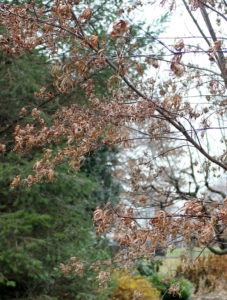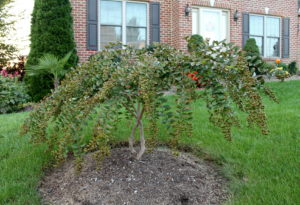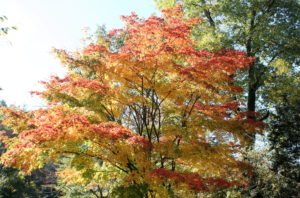What’s Killing the Japanese Maples?
November 21st, 2016
It’s pretty obvious what’s been killing our hemlocks (woolly adelgids), our ash trees (emerald ash borer), and our Douglas firs (needlecast disease).
What’s not as obvious is why so many Japanese maples have been struggling the past 2 to 3 years.
The trees I see are dying slow deaths. A few branches go leafless and die here and there until there’s nothing left after a few years.
A fungal, soil-borne disease called verticillium wilt is behind some of the demise, and so, too, is the erratic weather we’ve been having. But beyond that, there’s no single, blatant explanation for why so many of these beautiful specimens are biting the dust. Worse, there’s no quick and easy fix to make it stop.
Japanese-maple death has been going on to some degree for decades, but I started getting a lot more reports about 3 years ago. That coincided with the arrival of a January “polar vortex” – the fashionable term for a blast of sudden and brutal cold from the North.
I wrote off that trouble as an isolated winter-weather killing event.
But then another round of death and dying happened 2 years ago – this time what I suspected was related to a long string of unusually warm fall weather followed by a sudden temperature nosedive that zapped trees before they had a chance to prepare for cold.
That fall, Japanese maples never did put on their usual glorious red fall-foliage show. The leaves went straight from green (or in-season burgundy) to brown, and they failed to drop in mid-fall as they should’ve.

The fall before last, a sudden chill turned Japanese maple leaves brown before they had a chance to turn color.
This year, we didn’t have either of those. But we did have a relentlessly rainy May followed by a very dry summer in most areas. That’s potential double trouble for Japanese maples.
Japanese maples hate “wet feet,” so a combination of poor drainage and rain like we had in May can encourage a soil-borne fungal disease called phytophthora. This disease can kill trees branch by branch.
Japanese maples also hate drought conditions, and parched soil like so many of us had this summer can lead to leaf-margin browning, leaf curling and in bad enough cases, total leaf drop.
If all of that sounds like Acer palmatums might be a tad fussy, you’re right. I think Japanese maples are the finickiest of maples to grow, especially the lacy, thin-leafed “dissectum” types that also are especially beautiful.
I’ve concluded that getting them planted the right way and in a suitable spot, then giving them the right care is the difference between thriving and death.
Start by picking a part-shade spot that doesn’t get blasted by full afternoon sun. This limits heat and drought stress as well as the “bleaching” that excessive sunlight causes to the thin leaves. Burgundy ‘Bloodgood’ types look more washed-out brown to me in a hot late summer than burgundy.
If you’re going to plant in full sun, figure on having to water in hot, dry weather.
When siting, also look for a wind-protected spot, such as a courtyard or along the east side of a fence, building or evergreen windbreak. This keeps wind from drying the thin leaves and heads off the leaf tip burn that’s common from cold early-spring wind soon after the tender leaves first appear.
Good drainage is incredibly important in discouraging root-rot disease and encouraging good root growth that makes the tree less susceptible to drought stress.

Consider planting Japanese maples “high” in a mounded bed as Hampden Twp. gardener Hylton Hobday has done with this crape myrtle.
I’d always recommend working a couple of inches of compost or rotted leaves into the planting soil, but in lousy clay, I’d go so far as to “plant high.”
That means building a planting mound about 8 to 10 inches high and planting so that the top half of the root ball is above the surrounding grade. Make sure the whole rootball is covered with soil, but don’t pack it up against the trunk.
After planting, top the bed with 2 to 3 inches of organic mulch. Bark, shredded hardwood, wood chips or a combination of leaves and chipped branches are four good options. This holds down weeds, but more importantly, slows evaporation loss from the soil.
In a hot, dry summer, give Japanese maples a deep soaking once a week. For new or “newish” ones, twice a week is better.
All of this is aimed at keeping your Japanese-maple roots damp but never soggy.
Too much or too little water can be deadly by itself, but water extremes also are directly related to diseases – too much in the case of phytophthora and too little in the case of verticillium.
One thing not to do? Over-fertilize. Japanese maples are fairly light feeders, and they usually do fine with no supplemental fertilizer. You’ll actually make things worse if you try to fertilize a Japanese maple being stressed by something else (drought in particular). Only fertilize if a soil test tells you you’re lacking a specific nutrient.
Bugs occasionally are a factor. Microscopic nematodes, for example, can injure roots and make trees more vulnerable to verticillium wilt. That’s a very hard one to diagnose.
Scale is the most likely potential killer, and it’s much more obvious with the white, hard flecks you’ll see stuck to branches.
The bottom line is, a happy Japanese maple is a healthy Japanese maple. Or in other words, the more right things you can do, the less you’ll have to worry about a mysterious decline.








